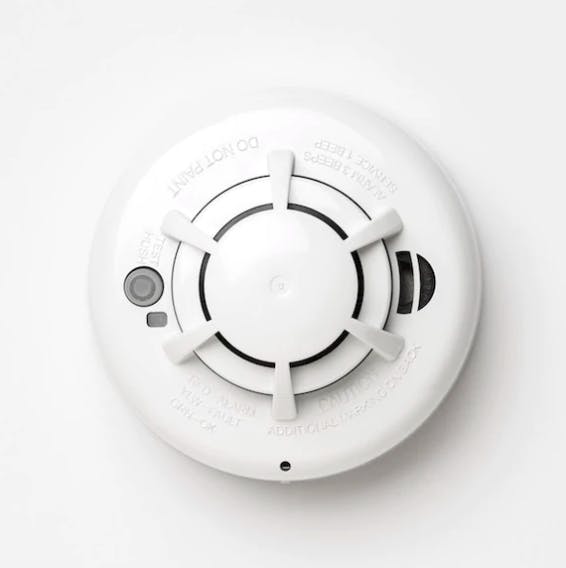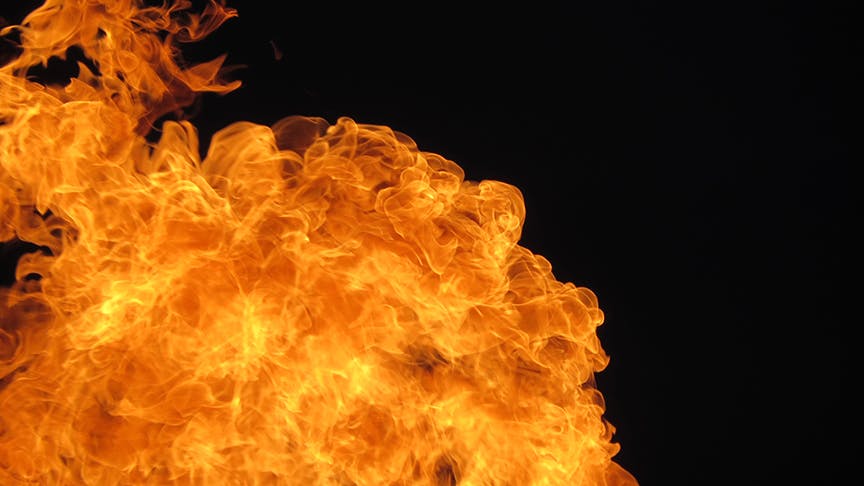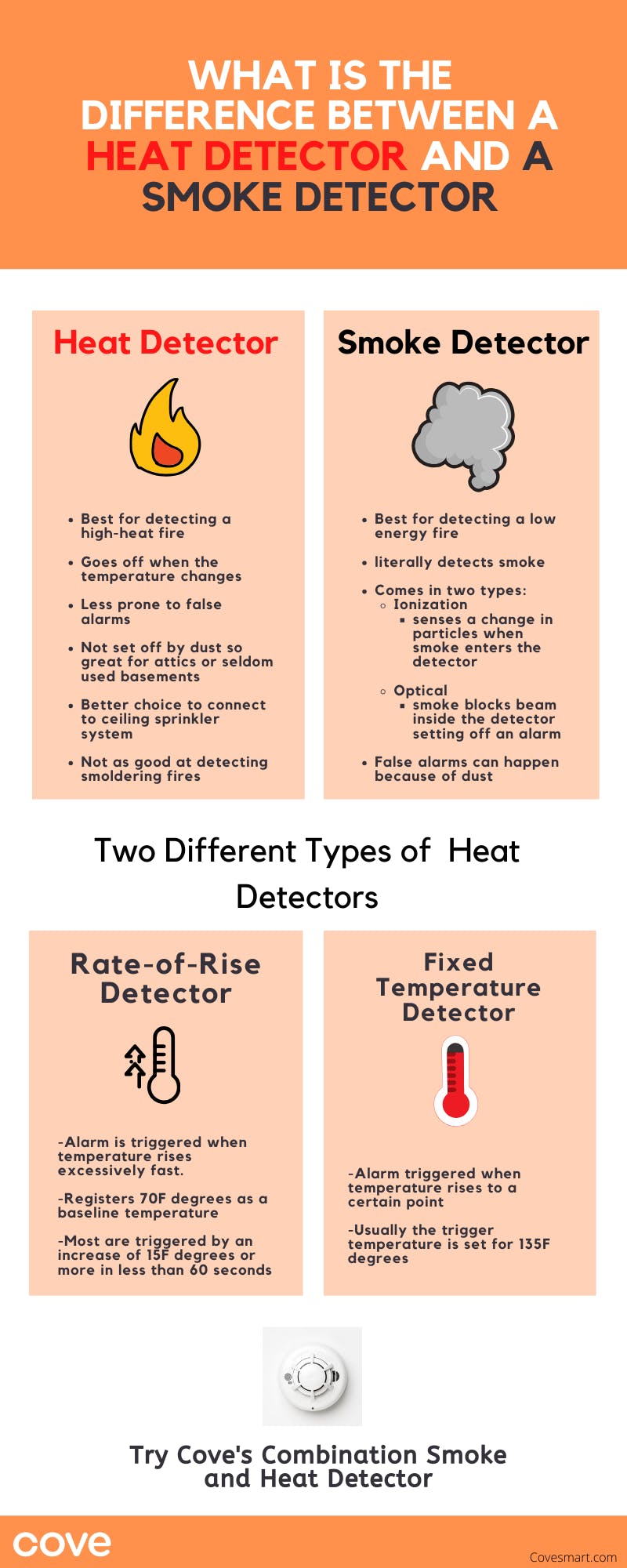
How a Heat Detectors Works
Every day, in the United States, 1,500 houses burn. Often, these fires are preventable, common house fires that were noticed too late. Fires only take a couple of minutes before they become uncontrollable, with flames reaching over 1,000 degrees Fahrenheit. House fires are dangerous, killing 6,500 and injuring 280,000 people every year.
The good news about fires is that, if they are caught before the flames escalate, the fire is easy to handle and easy to put out. Heat detectors and fire detectors save thousands of lives every year. Here’s how a heat detector can save your home.
What Is a Heat Detector?
A heat detector is a device that can sense heat in a room. Its purpose is to alert homeowners and business owners that there is a fire before the fire becomes irreversible. The device responds to convected thermal energy radiated from a fire. There are two main types of heat detectors on the market: rate-of-rise heat detectors and fixed temperature detectors.
Rate-of-Rise Heat Detector
Rate-of-rise heat detectors sense the heat in the room. The detectors register 70 degrees as a baseline; when the heat in the room rises rapidly above 70 degrees, the alarm is activated. This type of sensor is triggered by the “rate of change” rather than the temperature itself. Usually, the alarm is triggered when the rate of change is a 15 degree increase in less than a minute. When a house fire starts, the temperature in the room will rise rapidly—in some cases, the temperature will rise 30 degrees in 45 seconds.
Fixed Temperature Detector
The fixed temperature detector focuses on the actual heat in the room, rather than the rate of change. When the temperature in the room surpasses a preset number, the alarm is activated. Typically, the preset temperature that triggers the alarm is around 135 degrees. High temperatures are a good indicator of fire (unless you have your heater set to 135 degrees).
Both the rate-of-rise detectors and the fixed temperature detectors are great for sensing fires. However, heat detectors have drawbacks. Although they are great at heat detection, they won’t be able to detect a smoldering fire quickly. They are best for detecting high-heat fires.

Types of Fires for Heat Detection
Low-Energy Fire
There are two main types of fire: low-energy fires and high-heat fires. A low-energy fire smolders; it consumes fuel slowly and gives off a lot of smoke. However, this type of fire emits very little heat. Because this fire gives off more smoke than heat, thermal detection may fall short and take too long to detect this fire. By the time the heat sensor is activated, the fire will have caused severe damage to the home.
High-Heat Fire
The second type of fire is a high-heat fire. A high-heat fire consumes fuel quickly. As the fire eats, the flames grow higher and higher. These types of fires can be caused by an explosion or combustion. These fires feed off of easy-to-burn material such as paper, hay, or dry wood. This fire will trigger a heat detector fairly quickly. Heat Detectors are optimal for sensing this type of fire.

Heat Detector vs. Smoke Alarm
A heat detector is not the same device as a fire alarm. In fact, the two devices are very different. A fire alarm, or smoke alarm, reacts to smoke, while the heat detector reacts to heat. They have the same purpose but have different reaction times and different mechanisms.
There are two variations of smoke detectors: optical smoke detectors and ionization detectors.
Optical Smoke Detector
Optical smoke detectors sense smoke using an LED light. The light is shone within a small chamber inside the device. When smoke enters the chamber, the light is scattered, and the LED beam is broken (disrupted due to the smoke). When the beam is broken, the alarm is triggered.
Ionization Smoke Detector
An ionization detector uses an ionized chamber. To ionize the chamber, the device exposes a catalyst to the air. On one side of the chamber, there is a small hole for smoke to enter. When smoke enters the chamber, the ionization decreases, triggering the alarm. Even the smallest amount of smoke will cause the alarm to go off.
Smoke detectors sense fires within the first few moments. Smoke is the first sign of a fire, meaning that smoke detectors typically sense the fire quickly and efficiently. With a smoke sensor, fires are noticed and put out long before the fire can spread.
Smoke sensors are the most efficient way to detect a fire. Because there is typically smoke before a drastic heat change, smoke detectors sense fires faster than heat sensors. For everyday use in the home, smoke detectors are the best way to detect a fire. However, smoke detectors can be triggered falsely by dust, meaning that they are not the best device for dusty spaces such as attics or basements. Since heat sensors won’t be triggered falsely due to dust, they are the best device for that job.

How Does a Heat Detector Work with a Fire Alarm?
To get the best protection for your home, heat detectors should be paired with smoke alarms. The National Fire Alarm and Signaling Code require that a smoke sensor is installed in every sleeping room of the house. Fire alarms are also recommended in hallways, living rooms, and spare rooms. Smoke alarms can be replaced with heat detectors, though it’s not recommended. Smoke alarms are five times faster at detecting fire than heat detectors. Replacing a smoke sensor with a heat sensor in a bedroom can be dangerous.
Instead, heat alarms are meant to work with smoke detectors. Rather than replacing one with another, they should be used together. Each has different strengths that work to protect you.
The strengths of smoke detectors are:
- Detects Fires Quickly. Smoke detectors are the fastest way to detect fires. Since smoke is produced as soon as the fire starts, the detector can alert the homeowner seconds after the fire starts.
- Smart Capacity. Smoke detectors can be “smart,” meaning that they can be installed with a wireless home security system and synced with your mobile device. With this ability, the smoke detector can alert the homeowner to a house fire even when the homeowner is away. Rather than waiting for a neighbor to notice flames in the window, smoke detectors allow homeowners to proactively protect their homes and call for the fire department seconds after the fire has started.
- Detects Low Energy Fires. Not all fires are the same. Some fires, called low energy fires, emit only a small amount of heat but lots of smoke. These fires are hard for other fire detectors to sense. A smoke detector, on the other hand, can detect low energy fires faster than any other device on the market.

The strengths of a heat detector are:
- Less Prone to False Alarms. While smoke detectors are prone to false alarms, heat detectors are harder to fool. Heat detectors rely on the actual temperature of the room, and, if the temperature of the room hasn’t increased, the alarm won’t be activated.
- Protects Attics and Basements. Smoke detectors struggle to protect attics and basements due to the dust and other particles in the air. Heat sensors, on the other hand, can easily protect their areas without losing their efficiency. They maintain their effectiveness in a variety of rooms and situations.
- Used With Ceiling Sprinklers. Heat detectors are the number one choice for triggering ceiling sprinklers in a building. The last thing that a business would want is a false alarm that activates the sprinklers. However, if there is a fire, ceiling sprinklers can save the building. Because heat detectors are incredibly effective and hard to fool, they are the best choice for this job.
The key to using heat detectors is knowing where to use them. They are not the best choice for bedrooms or everyday fire protection. Heat detection is best used in areas where a smoke detector won’t be accurate, such as garages, sheds, barns, attics, and basements. Smoke detection works best in open areas, bedrooms, kitchens, living rooms, and dining rooms.

How Long Do Heat Detectors Last?
Heat detectors can be wired or wireless. Most home security experts recommend that homeowners use wireless, battery-operated heat detectors. Using batteries will make sure that the heat detector continues to work even if the power in the house is shut off. Wired alarms may face challenges during neighborhood blackouts. The batteries that are used to power heat sensors are extremely reliable and have been known to last up to 10 years without failing. However, to be safe, heat detectors batteries should be replaced every five years.
About once a year, homeowners should test the heat detector to make sure that the device is still working. Most heat detectors will have a small testing button on the device. When the button is pressed, the device will give a short few beeps, similar to a fire detector. Testing the heat sensor ensures that the thermal detection on the device continues to work properly.
The detector itself should last ten years without any issues. Heat detectors use a very small amount of energy to work. Thermal detection can actively work without requiring any additional energy for years. However, if you experience complications or problems while testing the thermal sensor, it’s best to have the device replaced.

Does a Heat Detector Protect Your Home?
Heat detectors are very capable at protecting your home. Combined with a smart smoke detector, heat detectors can give homes full protection from fires. While the smoke detector protects the home from low energy fires, heat detectors protect your home from high energy fires. High energy fires produce very little smoke and move quickly. They get hot fast and have high flames. Of course, they will still give off a small amount of smoke, so a fire alarm will still be able to alert the family. Having a heat detector will simply add an additional layer of protection.
Due to recent innovations in fire alarm technology, some fire alarms offer combined sensors. Combined sensors use both smoke detection and thermal detection to ensure that your home is protected from all fires.
Cove Security offers one of the best-combined sensors on the market. This fire detector can sense smoke, and tell the difference between the inorganic smoke and organic smoke. Inorganic smoke is smoke that comes from burning drywall, carpet, and treated wood. When the detector senses this type of smoke, the smart alarm will send you a notification alerting you that something that shouldn’t be on fire is on fire. Organic smoke is smoke that comes from burning wood, grass, hay, or other natural materials. If the sensor detects organic smoke in the air, the alarm will send you a different alert. With this alert, the sensor will ask you if the fire was intentional (such as an outdoor bonfire). If the fire is intentional, simply dismiss the notification and deactivate the alarm.
Cove’s smart fire detector offers more than smoke detection; it also offers heat detection. The heat sensor installed in the fire detector is a fixed thermal detector, meaning that the alarm activates when the air temperature reaches a specific heat for an extended period of time. For the best accuracy, the device monitors for three things:
- A temperature of 125 degrees for more than three minutes.
- A ten-degree increase in temperature in under one minute.
- If the temperature hits 125 degrees in under one minute (a combination of the first two).
In addition to having smoke detection and heat detection, the sensor also has freeze detection. Freeze detection alerts the homeowner if the indoor temperature is less than 41 degrees Fahrenheit or if the temperature in the home drops 10 degrees in under one minute.
Cove’s smart fire alarm helps homeowners to fully protect their homes from every possible threat. Homeowners are often exposed to a variety of dangers, including floods, fires, and earthquakes. Cove Security endeavors to protect homeowners and give them more control—Cove’s smart alarm systems protect homes and offers affordable security.
